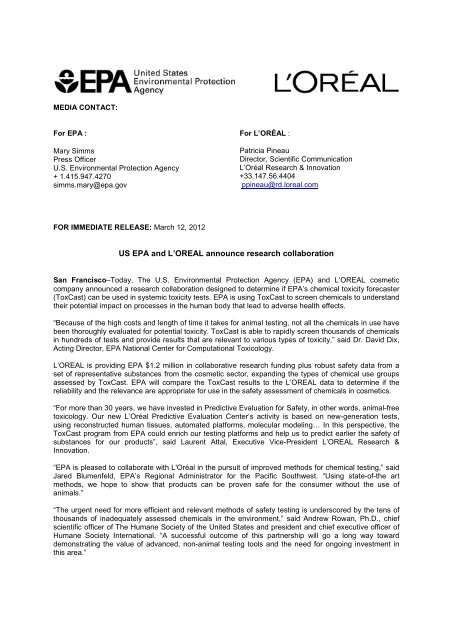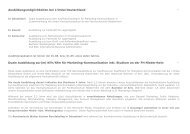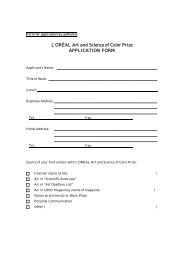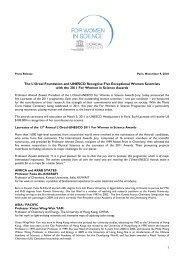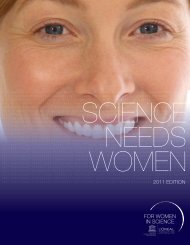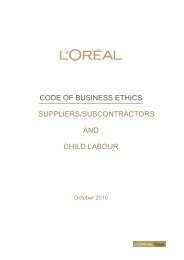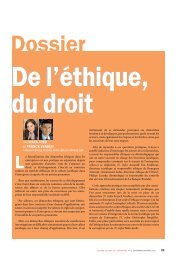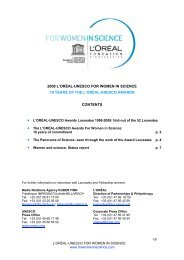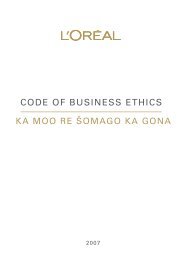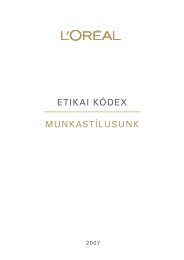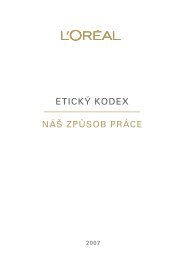2012 Epa loreal joint press release
2012 Epa loreal joint press release
2012 Epa loreal joint press release
You also want an ePaper? Increase the reach of your titles
YUMPU automatically turns print PDFs into web optimized ePapers that Google loves.
MEDIA CONTACT:<br />
For EPA :<br />
Mary Simms<br />
Press Officer<br />
U.S. Environmental Protection Agency<br />
+ 1.415.947.4270<br />
simms.mary@epa.gov<br />
FOR IMMEDIATE RELEASE: March 12, <strong>2012</strong><br />
For L’ORÉAL :<br />
Patricia Pineau<br />
Director, Scientific Communication<br />
L’Oréal Research & Innovation<br />
+33.147.56.4404<br />
ppineau@rd.<strong>loreal</strong>.com<br />
US EPA and L’OREAL announce research collaboration<br />
San Francisco–Today, The U.S. Environmental Protection Agency (EPA) and L’OREAL cosmetic<br />
company announced a research collaboration designed to determine if EPA’s chemical toxicity forecaster<br />
(ToxCast) can be used in systemic toxicity tests. EPA is using ToxCast to screen chemicals to understand<br />
their potential impact on processes in the human body that lead to adverse health effects.<br />
“Because of the high costs and length of time it takes for animal testing, not all the chemicals in use have<br />
been thoroughly evaluated for potential toxicity. ToxCast is able to rapidly screen thousands of chemicals<br />
in hundreds of tests and provide results that are relevant to various types of toxicity,” said Dr. David Dix,<br />
Acting Director, EPA National Center for Computational Toxicology.<br />
L’OREAL is providing EPA $1.2 million in collaborative research funding plus robust safety data from a<br />
set of representative substances from the cosmetic sector, expanding the types of chemical use groups<br />
assessed by ToxCast. EPA will compare the ToxCast results to the L’OREAL data to determine if the<br />
reliability and the relevance are appropriate for use in the safety assessment of chemicals in cosmetics.<br />
“For more than 30 years, we have invested in Predictive Evaluation for Safety, in other words, animal-free<br />
toxicology. Our new L’Oréal Predictive Evaluation Center‘s activity is based on new-generation tests,<br />
using reconstructed human tissues, automated platforms, molecular modeling… In this perspective, the<br />
ToxCast program from EPA could enrich our testing platforms and help us to predict earlier the safety of<br />
substances for our products”, said Laurent Attal, Executive Vice-President L’OREAL Research &<br />
Innovation.<br />
“EPA is pleased to collaborate with L'Oréal in the pursuit of improved methods for chemical testing,” said<br />
Jared Blumenfeld, EPA’s Regional Administrator for the Pacific Southwest. “Using state-of-the art<br />
methods, we hope to show that products can be proven safe for the consumer without the use of<br />
animals.”<br />
“The urgent need for more efficient and relevant methods of safety testing is underscored by the tens of<br />
thousands of inadequately assessed chemicals in the environment,” said Andrew Rowan, Ph.D., chief<br />
scientific officer of The Humane Society of the United States and president and chief executive officer of<br />
Humane Society International. “A successful outcome of this partnership will go a long way toward<br />
demonstrating the value of advanced, non-animal testing tools and the need for ongoing investment in<br />
this area.”
EPA researchers have published scientific papers showing how ToxCast can be used to predict a<br />
chemical’s potential for liver toxicity, developmental toxicity, reproductive toxicity and cancer. ToxCast is<br />
screening over 1,000 chemicals in over 700 fast, automated tests (called high-throughput screening).<br />
ToxCast is supplemented by the Toxicity Testing in the 21 st century federal agency research collaboration<br />
that uses robotics to test the chemicals.<br />
More information on ToxCast: http://www.epa.gov/ncct/toxcast/


